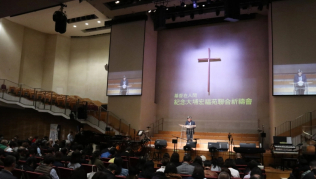WASHINGTON - Anita Wamble, of the Martin Luther King Jr. National Memorial Project, has a dream.
Wamble, a member of Grace United Methodist Church in Fort Washington, Md., dreams of a time when her two children can visit a monument to the civil rights leader on the National Mall in Washington. As the project's major gift officer, she is working to make that $100 million dream a reality. This year will be a pivotal time in her efforts.
In 1988, Congress approved plans developed by the Alpha Phi Alpha Fraternity for the monument, which will be situated on a four-acre site along the Tidal Basin. The site is adjacent to the Franklin D. Roosevelt Memorial and in a direct line between the Lincoln and Jefferson memorials.
Wamble calls it a "visual line of leadership" that links the principles of freedom from the founding fathers through the civil rights movement. The monument would be the first on the National Mall honoring an individual other than a president and the first to pay tribute to an African American, she said.
The design, created by the ROMA Design Group architectural firm of San Francisco, was selected in 2000 in a bid that drew more than 900 submissions from 52 countries. It is based on the themes of justice, democracy and hope and will use water, stones and trees.
Hope is a theme that greatly appeals to Wamble, a certified lay speaker and chairwoman of Christian education at Grace United Methodist Church. She pointed out that the civil rights movement was born and nurtured in pulpits.
King often spoke of the "stone of hope" cast out of the "mountain of despair," she said. Portions of King's sermons and speeches will be inscribed in the glistening, smooth surfaces of a water wall. A carving of King will appear as a part of the stone of hope. The carving will reveal King's shape in a slow and artful way.
King's image will be seen looking across the Tidal Basin, according to materials on the project's Web site (http://www.mlkmemorial.org/). He will be "pointing with a pencil back to his words in 'The Promissory Note' as if, having just written these words, he is now standing vigil and awaiting the delivery of the note."
King spoke these words in Washington in 1963: "When the architects of our republic wrote the magnificent words of the Constitution and the Declaration of Independence, they were signing a promissory note to which every American was to fall heir. This note was the promise that all men, yes, black men as well as white men, would be guaranteed the 'unalienable rights' of 'life, liberty and the pursuit of happiness."
In raising funds for the monument, Wamble feels that she is, in some small way, helping to collect on this debt. She left her job at the American Red Cross to raise funds, believing "there were ideals of freedom involved in creating this touchstone of history."
In today's economy, raising money for the project is not easy, she admitted. To date, $25.4 million has been raised, and $50 million is needed before ground is broken in November, Wamble said. By November 2006, all $100 million must be secured. Her task is to identify and work with contributors who pledge gifts of more than $100,000.
"To raise $25 million by November, that's where my faith comes in," she said. "Looking at the economics, one might say we can never do it. But we need to look at it through eyes of faith. What man calls impossible, God calls possible."
Raising the funds means contributing to King's legacy, helping keep alive the message that all people are equal in God's sight, Wamble said. It's especially important for her to share this message with her children, she added.
Recent local surveys indicate that 97 percent of children could identify Martin Luther King Jr., Wamble said. However, 68 percent couldn't place him in the 1960s, and one out of three couldn't identify him as a leader of the civil rights movement.
On King's birthday, Wamble teaches the students at her children's school about their history. It's important that they know the shoulders of those they are standing on are wide, she said.
Looking around the classroom, she noted white, black, Hispanic, Arab and Asian children and those from other cultures learning together. That scene would never have occurred in Wamble's childhood school in the 1970s. This is part of King's dream coming true, and that dream needs a tangible monument, according to Wamble.
"As a nation we learn that without one another we wouldn't be able to get through life."
By Melissa Lauber







